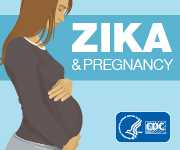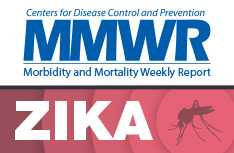Types of Zika Virus Tests
If you have a symptomatic patient who lives in or recently traveled to an area with risk of Zika, he or she may have been infected with other mosquito-borne viruses like dengue or chikungunya that often circulate in the same geographic regions and present with a similar clinical illness.
The FDA has issued Emergency Use Authorization (EUA) for several diagnostic tools for Zika virus, including the Trioplex Real-Time RT-PCR (rRT-PCR) assay and the Zika MAC-ELISA, which are being distributed by CDC to qualified laboratories.
Molecular Test for Zika Virus
For symptomatic persons with Zika virus infection, Zika virus RNA can sometimes be detected early in the course of illness. RNA NAT (nucleic acid testing) should be performed on paired serum and urine specimens. For symptomatic pregnant women with possible exposure to Zika virus, NAT should be performed concurrently with IgM serology. For asymptomatic pregnant women with ongoing possible exposure to Zika virus, NAT is recommended three times during pregnancy. For asymptomatic pregnant women with recent possible exposure but no ongoing Zika virus exposure (i.e., travelers), NAT may be considered on a case-by-case basis using a shared physician-patient decision-making model and should follow the testing algorithm for symptomatic pregnant women. For pregnant women with possible exposure to Zika virus and who have a fetus with prenatal ultrasound findings consistent with congenital Zika virus infection, NAT should be performed on maternal urine and serum concurrently with IgM serology following the testing algorithm for symptomatic pregnant women. If amniocentesis is performed, NAT of amniocentesis specimens should also be performed. NAT testing of symptomatic, non-pregnant individuals should be performed on specimens collected <14 days post-symptom onset. NAT testing is not recommended for asymptomatic non-pregnant individuals. A negative NAT result does not exclude Zika virus infection.
Trioplex Real-time RT-PCR Assay
The Trioplex rRT-PCR is a laboratory test designed to detect Zika virus, dengue virus, and chikungunya virus RNA. The Food and Drug Administration (FDA) has authorized the use of this test under an Emergency Use Authorization (EUA). More information on the Trioplex rRT-PCR assay can be found on the Lab Guidance webpage.
Zika Virus – Trioplex Real-Time RT-PCR Assay Testing Instructions:
See Understanding Zika Virus Test Results for Healthcare Provider and Patient Fact Sheets on the Trioplex Real-Time RT-PCR Assay.
Serologic Test for Zika Virus
Zika virus-specific IgM and neutralizing antibodies typically develop toward the end of the first week of illness. IgM levels are variable, but generally are positive starting near day 4 after onset of symptoms and continuing for up to 12 weeks post symptom onset or exposure, but may persist longer. For symptomatic pregnant women, IgM serology is performed concurrently with NAT. For asymptomatic pregnant women, if testing is conducted, IgM serology should follow the testing algorithm for symptomatic pregnant women. For pregnant women with possible exposure to Zika virus and who have a fetus with prenatal ultrasound findings consistent with congenital Zika virus infection, IgM serology should be performed on maternal serum concurrently with NAT following the testing algorithm for symptomatic pregnant women. For symptomatic non-pregnant individuals, testing should be performed on NAT negative samples collected <14 days after onset of symptoms or on samples collected ≥14 days after onset of symptoms. IgM testing is not recommended for asymptomatic non-pregnant individuals.
Zika MAC-ELISA
The Zika IgM Antibody Capture Enzyme-Linked Immunosorbent Assay (Zika MAC-ELISA) is used for the qualitative detection of Zika virus IgM antibodies in serum or cerebrospinal fluid; however, due to cross-reaction with other flaviviruses and possible nonspecific reactivity, results may be difficult to interpret. Consequently, presumed positive, equivocal, or inconclusive tests must be forwarded for confirmation by plaque-reduction neutralization testing (PRNT). PRNT is performed at CDC, a laboratory designated by CDC (i.e., a laboratory that has independently demonstrated proficiency to perform PRNT testing by completing a proficiency panel provided by CDC), or a public health laboratory (PHL) PRNT Reference Center to confirm presumed positive, equivocal, or inconclusive IgM results. Additionally, IgM testing cannot be relied upon to distinguish between recent or distant infection.
Resources for US Laboratories
- EUA-specific CDC Zika MAC-ELISA Instructions
English [PDF – 95 pages] | Spanish [PDF – 99 pages] | French [PDF – 96 pages] - EUA-specific Reagents and Supplies for CDC Zika MAC-ELISA
English [PDF – 1 page] | Spanish [PDF – 1 page] - EUA-specific Titration of Reagents in the CDC Zika MAC-ELISA
English [PDF – 3 pages] | Spanish [PDF – 3 pages]
Resources for International Laboratories
- Non-EUA CDC Zika MAC-ELISA Instructions
English [PDF – 24 pages] | Spanish [PDF – 25 pages] - Non-EUA Reagents and Supplies for CDC Zika MAC-ELISA
English [PDF – 1 page] | Spanish [PDF – 1 page] - Non-EUA Titration of Reagents in the CDC Zika MAC-ELISA
English [PDF – 3 pages] | Spanish [PDF – 3 pages]
See Understanding Zika Virus Test Results for Healthcare Provider and Patient Fact Sheets on the MAC-ELISA Test
Plaque Reduction Neutralization Test (PRNT)
Specimens with a negative Zika virus NAT and non-negative serology results, including positive, presumptive positive, possible, equivocal, or inconclusive, must be forwarded to CDC, a laboratory designated by CDC (i.e., a laboratory that has independently demonstrated proficiency to perform PRNT testing by completing a proficiency panel provided by CDC), or a public health laboratory (PHL) PRNT Reference Center for confirmation by PRNT.
For more information on interpretation of diagnostic test results, see Update: Interim Guidance for Health Care Providers Caring for Pregnant Women with Possible Zika Virus (MMWR, July 24, 2017).
- Page last reviewed: July 23, 2017
- Page last updated: July 23, 2017
- Content source:





 ShareCompartir
ShareCompartir